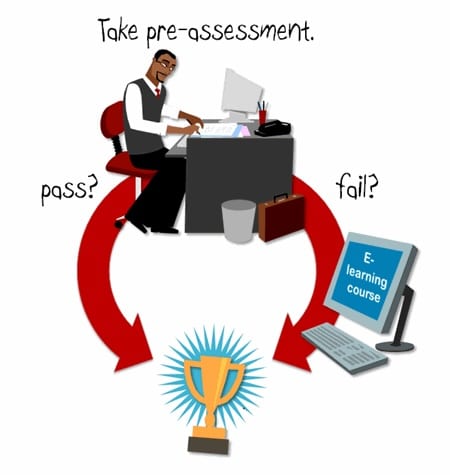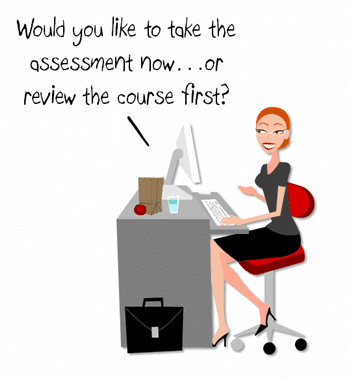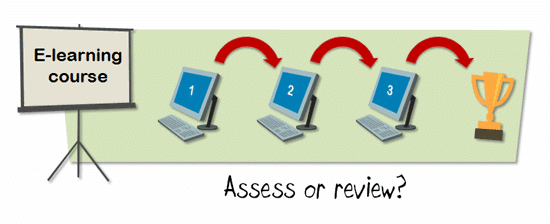3 Tips to Create More Effective Compliance Training
Discover three effective strategies to streamline your compliance training, save time and resources, and keep your employees engaged while meeting certification requirements.

Make your compliance training something that works for the organization
Are you tired of creating time-consuming compliance courses that fail to engage your employees? Previously, we explored issues with compliance-based e-learning and discussed how a different design approach can save your organization time and money while making your employees happier.
This post introduces three practical strategies to streamline your e-learning process, ensuring you meet certification requirements while saving time and resources. Discover how to make your compliance training more efficient and user-friendly.
Often, we base our approach to building compliance training on hearsay or regulatory urban legends. This results in bloated, time-consuming courses that only serve the purposes of sleep-deprived insomniacs. One key point from the previous post was to contact your legal department and determine your organization’s actual requirements. Build your training around these requirements rather than what you think the regulations say.
The ideal approach meets your compliance needs while identifying legitimate gaps in understanding. This allows you to address those gaps and provide interventions that bring people up to the desired skill and performance level.
1. Create a pre-assessment
Place the certification test at the beginning of your course. Make it comprehensive to truly identify the learner’s knowledge and skill level. If the user passes the test, they jump to the end and receive certification. If not, direct them to the course for remedial training and additional assistance.

Remember, an assessment doesn’t have to be a standard multiple-choice or true/false quiz. You can design it as a series of case studies or scenarios, as well as a traditional quiz.
How you design the assessment and course is up to you. Use a simple linear approach or create a dynamic scenario-based process. The key is to make the assessment more than a click-and-read process—make it as engaging as you want.
2. Empower the user
While creating an upfront assessment is simple and easy to design, some users might find it intimidating. Here’s a way to soften the approach and empower learners: instead of starting with the assessment, give users a choice. Tell them they can go through the course and attempt the assessment at any time. Unlock the course so users can navigate it and see what’s covered.

Think of it like browsing a book in a store. You look at the table of contents, check the index for specific areas of interest, and flip through the pages to see illustrations and examples. It’s your way of assessing the book’s value and relevance.
Similarly, many people like to skim through e-learning course content to get a sense of what’s included. Once they see the content and layout, they can determine if they need the course to help them pass the assessment. That’s why it’s important to unlock the course and give learners room to explore.
Remember, these courses are for people who likely already know the content and just need to demonstrate it for certification. It’s like an experienced driver getting a new license – they don’t need a driving class, just a test to prove their skills.
This approach lets users see what’s required and mentally assess their knowledge. They can explore a few sections to test their comfort level and take the assessment when ready. Odds are, they’ll self-assess, identify areas where they need more information, and review those sections.
3. Break the content into sections
Even with the option to create courses with pre-tests, some organizations still request a formal “course.” Some clients believe that reviewing information doesn’t hurt, even if people already know it. Others aren’t comfortable with allowing users to self-navigate and choose when to take the assessment.
For these situations, consider the following approach: break the course content into distinct sections. At the beginning of each section, give users a choice to assess or go through the content. Conduct a final assessment at the end of all sections.
This approach still captures time savings because knowledgeable people can quickly test out of each section. By breaking it into sections, you can be more specific in the assessment process and identify areas where people might not be as fluent.

For example, if you only had one assessment for a course, a person might pass at 80% and be certified. However, what if the 20% they got incorrect was all from the same area? That could be a potential problem.
The advice in this post probably doesn’t work for courses teaching new skills. However, if you do a lot of certification or annual refresher training, these three approaches should prove useful.
Empower learners and optimize your compliance training
By implementing pre-assessments, empowering users with choices, and breaking content into manageable sections, you can significantly improve your compliance training effectiveness. These strategies not only save time and resources but also create a more engaging learning experience for your employees.
For a little inspiration, check out this case study from customer Intermountain Health. Learn how they successfully leveraged Storyline to create test-out opportunities for learners to skip content they’ve mastered.
You may also like

Translation vs. Localization: What’s the Difference?
Compare the difference between translation vs. localization and find out how to choose the best approach for your global workforce training needs.

